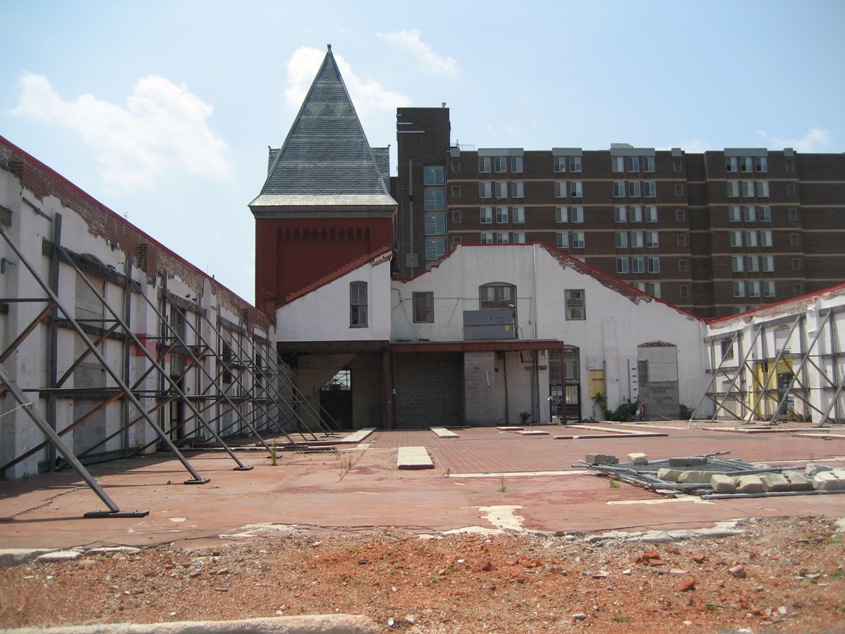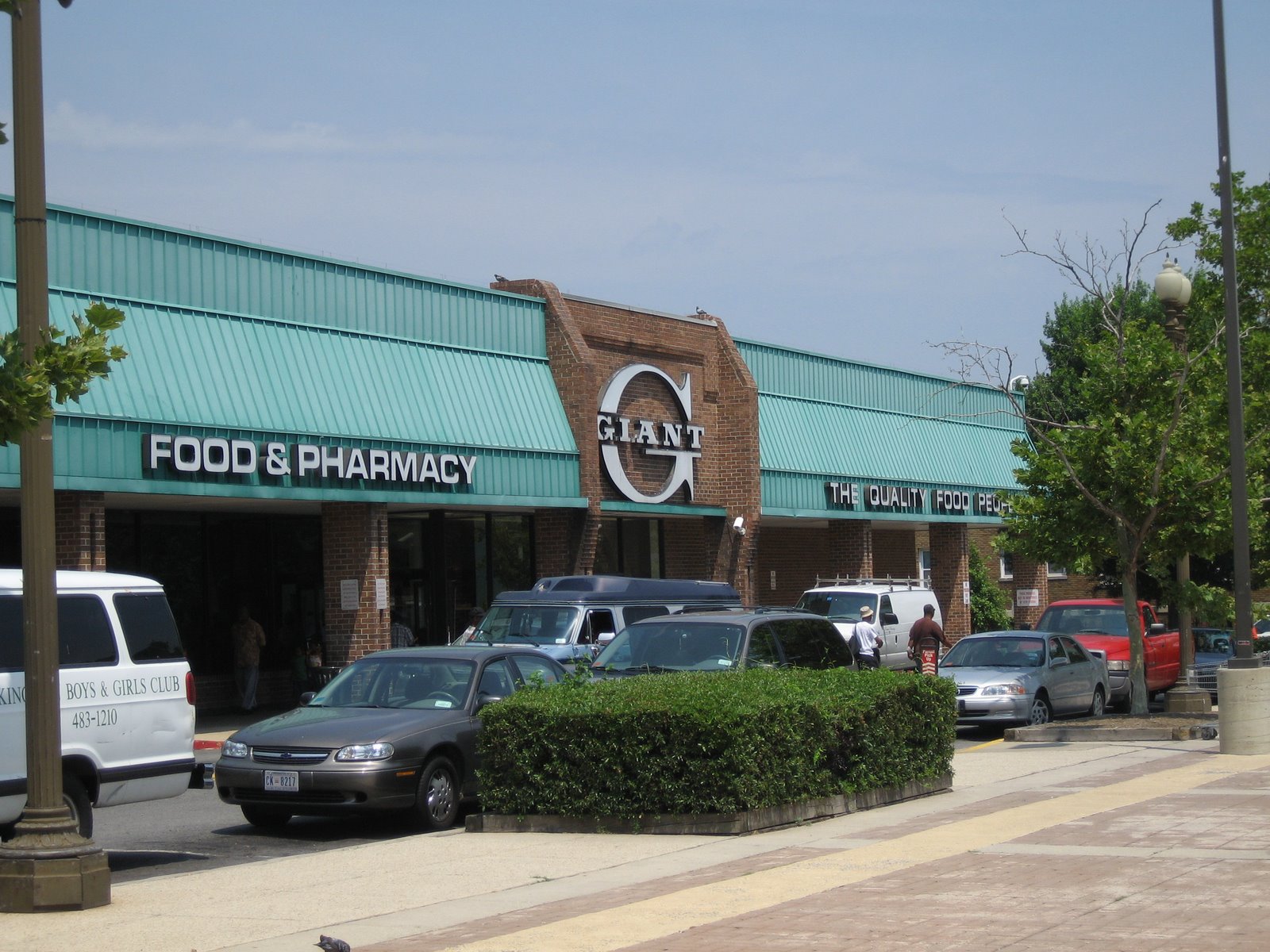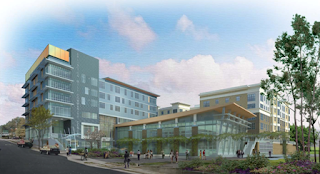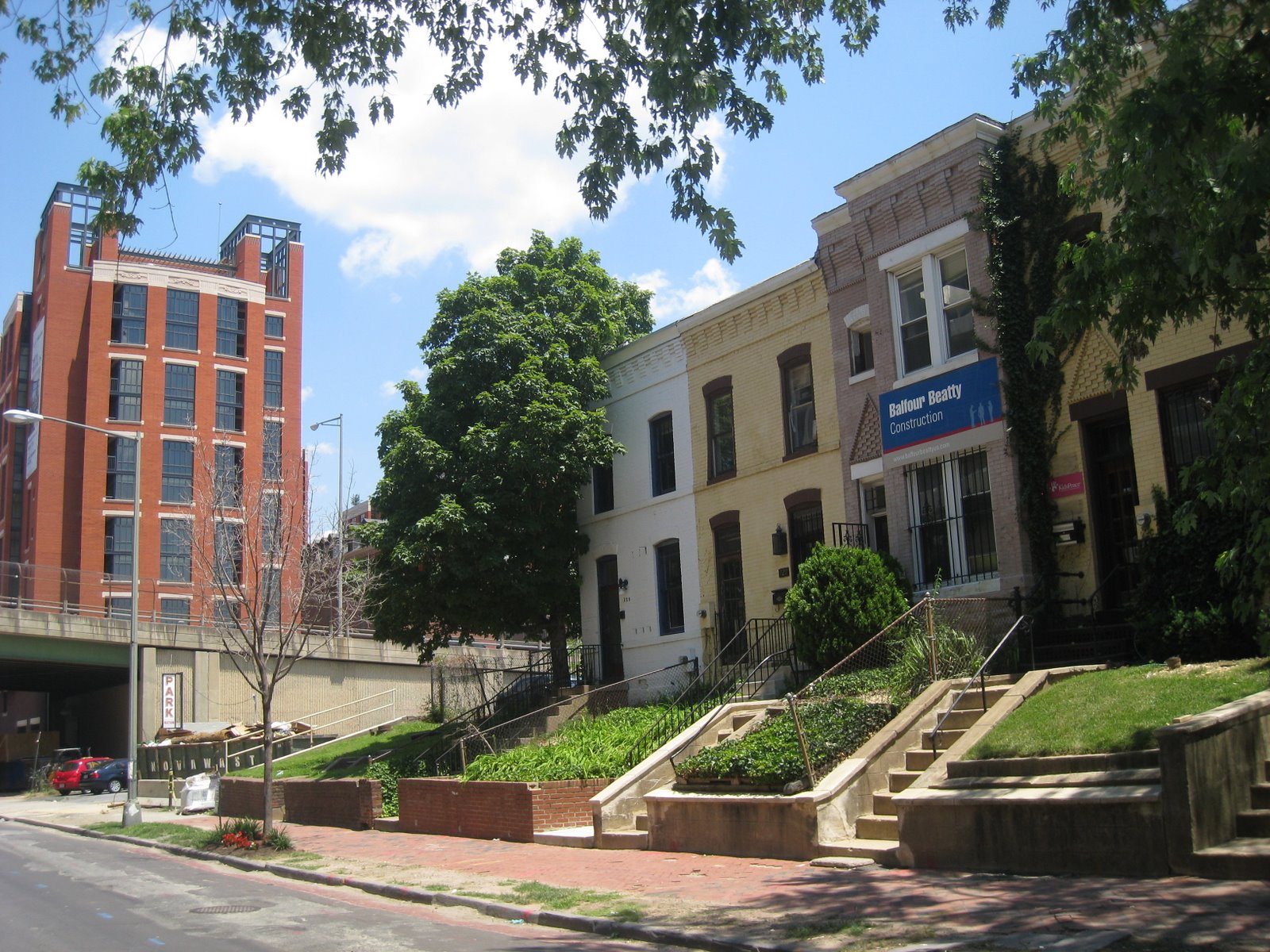 He may not get microphone time at every press conference or a pair of scissors at every ribbon cutting, but Neil Albert, Washington DC's Deputy Mayor for Planning and Economic Development, keeps busy as the man behind the curtain for development in DC. Despite a schedule kept full by the 10,000 new affordable housing units he has been charged with creating in his first four years, Albert made time to sit with DCMud to discuss the latest RFPs, affordable housing, and why he thinks DC can shed its monumental, federal skin and become an full-fledged international city.
He may not get microphone time at every press conference or a pair of scissors at every ribbon cutting, but Neil Albert, Washington DC's Deputy Mayor for Planning and Economic Development, keeps busy as the man behind the curtain for development in DC. Despite a schedule kept full by the 10,000 new affordable housing units he has been charged with creating in his first four years, Albert made time to sit with DCMud to discuss the latest RFPs, affordable housing, and why he thinks DC can shed its monumental, federal skin and become an full-fledged international city.
You went from working with the previous Mayor as Deputy Mayor for Children and Families to the Deputy Mayor for Planning and Economic Development. How did you get into development?
Albert: I started in finance and headed a nonprofit in New York. I was interested in parlaying that expertise into development on a small scale. I had the opportunity to really get into development when I was Parks director; a large part of what I did was real estate development. We built a number of recreational facilities in the city, including the first LEED-certified facility in DC. I then became
Deputy Mayor of Children Youth and Families because that portfolio was one of the ones that needed a little shaking up and focus and energy. The former mayor asked me to do it and I did it for a year. Then I went into the private sector and started a nonprofit working with DC schools in professional development and bricks and mortar actually building new schools. I’ve always had a real estate finance focus throughout my career.
When the mayor-elect asked me to join his administration in this role, I thought it was a great opportunity to put what I’ve been doing together. What I do is not just about financial real estate development, but there is a human component to what we do. A major part is the
New Communities portfolio, the human capital – HOPE VI-type developments. We’ll be removing a lot of traditional government subsidized housing to create more mixed income housing. Part of that is changing psyche, the mindsets; preparing them to be able to write a red check, go to work every day like everybody else.

Speaking of subsidized housing, the bar for the amount of subsidized housing private developers must provide is being raised from 20-30 percent. On what basis was that decision made?
Albert: That decision was made before us. When the Anacostia Waterfront Corporation was dissolved, the Council adopted legislation that required the affordable housing component - that’s the majority of what my office works on. By default, it has become standard here.
How does that play into some of the other new developments the city has issued RFPs for - in which the city asked for 30 percent but is not doing the workforce housing? It’s like the city is focusing on lower income development.
Albert: The mayor made a real commitment to affordable housing when he was elected and we are committed to building over 10,000 units in the first four years at different AMI levels, so all RFPs have the 30 percent requirement and our language is pretty general because we want to make sure that we achieve affordable housing levels without paying unnecessarily for it. And so what drives affordable housing in mixed-income developments is having market-rate housing that can actually subsidize lower income housing without having to come to the District government for subsidies.
We want true diversity in housing. Whether it’s
Hill East,
Poplar Point,
5th and I, including the affordable component is necessary to have the correct mix.
These are perhaps not the best times for condo builders. How does that play into the marketability of a project during difficult times?
Albert: I don’t know if it makes it more difficult. From our experience, in the last few years, the development community has embraced not necessarily the 30-30-30 mix, but at least the 30 percent affordable component. City Vista is an example, and I think that’s kind of what’s driving that project being sold. It came on line at a time when the condo markets were going in the wrong direction, so having twenty percent of the units as affordable provided some stability. The market on the affordable level was much greater than the market than on market-rate level. The results and feedback from the development community have been positive. Yes, people like to make as much profit as possible, but we have to balance their need for the highest return with the broader city policy and goals for providing affordable housing.
You referenced City Vista and other projects that have an affordable housing element. Some developers have told us that they are having some difficulty finding qualified people and actually bringing them to the table, that this makes their job more difficult. Have you ever studied that?

Albert: I would say they need to try a little harder. We can do a better job as a government, having a central repository database, which we are working on. I know the city Council actually passed legislation that will require a sort of central registry for those interested in taking advantage of affordable housing projects. In some cases it’s about us doing a better job preparing applicants; it’s a huge education process that needs to go into preparing people for home ownership. You can’t just get up one day and decide to be a home owner. When you buy a condo, pay the fees, have to abide by the rules of the condo board or association - you have to have a down payment, some sort of reserve in case the AC breaks and it’s not the condo association’s responsibility - we can do a better job of preparing those in that income category to take advantage of these opportunities. In that case, yes, people have gone to the table and not closed.
Where did the 10,000 unit figure come from?
Albert: The 10,000 number came out of a housing task force in the Williams administration, and then-Councilmember Fenty introduced legislation that set up this Comprehensive Housing Strategy Task Force and they made a recommendation that the city needed to build 55,000 new units of housing over the next ten years to deal with the population increase, special needs housing, etc. And then they broke down some sub categories – 19,000 affordable, and for those affordable units, there were some smaller ranges that included special needs 2,500 units, etc.
We wanted to make sure that we could achieve that in a ten year period, so we set a goal of 10,000 in first four years, so with about 2,500 a year we are well on our way to at least funding those projects. We’re not only calling for them, we are providing funding for them through the housing production trust fund and some of the other housing sources available. I am confident that we’re going to make that.
In terms of your position, you have a huge hand in what happens in terms of development, and development seems very high on Fenty’s list given his appearances at development press conferences. How do you want DC to be perceived from a national standpoint, what are your development goals?
Albert: We want to truly make a diverse city here, but my opinion is that we have the great opportunity of positioning this city as a great international city on par with Paris and London and Amsterdam. People talk about great cities and I see DC as one of those. We are not on the cusp of that yet, we have a little ways to go, but I think we’ve got the major elements coming together. We have a vibrant downtown, people want to be here, and every vacant office building is being gobbled up by big lobbying firms or law firms or national organizations that need to be near the seat of power.
We’ve started to pay attention to our retail. We can now shop in DC, when I came here eight or nine years ago, you couldn’t do that. Now there are good restaurant choices, you have really great options springing up and also good entertainment options. The Washington Post did an article about how DC is no longer a daytime town, it’s becoming a nighttime destination, so you don’t just leave the office canyons and go home to the suburbs, you go to night clubs and restaurants in the central business district.

What I think will put us on par with some of the mature cities that make a statement both locally and internationally is having kind of the right balance between cultural amenities, which we have a lot of in our museums, but also local cultural amenities like the
Spy Museum and Madam Tussaud’s; cultural amenities not just downtown, but also in other neighborhoods. We have lots of theaters and shopping destinations, so that when tourists come, they are not just sleeping in hotels and visiting the Mall, but also getting into the neighborhoods and discovering them. So what I would like us to be known for is raising the bar to be a city on par with a lot of the other international cities. And right now, we kind of lay in the shadow of great U.S. cities, but we are still holding our own.
How do you see your specific role and interaction with the private development community and with residents of the city - how do you mix the two?
Albert: I see myself as convener of private sector and the natural community residents who sometimes have needs that complement each other and sometimes oppose each other. In many cases, my role is just to be the arbitrator. Getting the services from the private sector that the residents need, whether it is incentives or bringing offices to neighborhoods so people don’t have to jump into a car to get to work, but can hop one metro stop to another. I really see my role as a convener or facilitator of those communities. I am really concerned about the amount of new jobs we create in the District, I’m happy to say that even while the rest of country is going through a downturn, we are still seeing job growth in DC.
Traditionally, you look at the government as the creator of jobs. In the District they still are, but the service industry is also creating new jobs in entertainment, restaurants, retail and the federal government is doing its role by positioning government agencies in the District – the
DOT by the ballpark or the
ATF building at New York Avenue. They put us in partnership with each other to keep the economy going.
Our job is bringing the balance between the haves and the have-nots in DC, so we have the big law and lobby firms and the non-profits and the associations who are squeezed by real estate taxes right now, but that add to the flavor of DC. Instead of them having to relocate to suburbia, we step in and try to provide incentives to keep them here. We are trying to keep a vibrant balance of community within the city.
The city has issued a number of development RFPs. When will we see some selections?
 Albert:
Albert: 5th and I will be announced soon, and Minnesota- Benning, we are so excited about that project, but we won’t make a selection until August. The developers up for that are
City Interest who owns the East River Shopping Center and Parkside,
Donatelli Development, and
Marshall Heights Community Development Organization which is partnering with
Rick Walker who did the Home Depot and Brentwood Shopping Center by the Rhode Island Avenue Metro station. They are all competing for the 600,000 s.f. of developable space.
And Tenleytown?
Albert: Tenley is still outstanding; we’ll hopefully have a decision soon.
Can we ask about MIZ (Mandatory Inclusionary Zoning, requiring most developers to build subsidized units)? Councilmember Graham has been vocal about moving it forward…
Albert: Yes, the mayor is committed to MIZ, but he wants to do it in a way that doesn’t slow or stop the development of mixed-income housing. My job is to do it right. We are getting comments from a wide cross section of the city including the private sector, affordable housing providers, and advocates.

We issued administrative regulations two months ago for comments. We are going to take those comments and reissue a draft of the regulations and put it out for final vetting and hopefully make a decision in the next sixty to ninety days. I also believe that the housing development community will embrace it because I think we’ll do it in a responsible way that’s non-punitive. Then, we’ve been looking across the country to see how this has worked. It’s a mixed bag but it’s going to happen.
Finally, developers have told us that they struggle with the amount of information that has to be provided with a PUD and with the amount of time it takes to get approval for projects in DC. What is your response to that?
Albert: I totally agree. We are working on it; the
Office of Planning will be sending suggestions about how to streamline the process in the entire District. The PUD shouldn’t take 18 months anywhere in the world, not to mention the DC area.
 The District of Columbia announced today an agreement with Roadside Development to help finance the O Street Market, a mixed-use development that will likely be the showpiece for a revitalized Shaw. The deal will provide a $35 million tax increment financing (TIF) package to help developers bridge a financial gap and achieve the $260 million needed for the project. The current market, built in 1881 and now a crumbling memento of the neighborhood's failure to attract the investment, has sat vacant for years, but will now be transformed into a mixed-use anchor that will include 630 residential units, 80-100 of which will be affordable, senior housing units, a 200-room hotel, a 560-space parking garage and 87,000 s.f. of retail that maintains the historic facade. Giant will replace its 28-year-old Giant grocery store with CityMarket, a 71,000 s.f. store that will be the largest supermarket in DC and the largest Giant store in the chain.
The District of Columbia announced today an agreement with Roadside Development to help finance the O Street Market, a mixed-use development that will likely be the showpiece for a revitalized Shaw. The deal will provide a $35 million tax increment financing (TIF) package to help developers bridge a financial gap and achieve the $260 million needed for the project. The current market, built in 1881 and now a crumbling memento of the neighborhood's failure to attract the investment, has sat vacant for years, but will now be transformed into a mixed-use anchor that will include 630 residential units, 80-100 of which will be affordable, senior housing units, a 200-room hotel, a 560-space parking garage and 87,000 s.f. of retail that maintains the historic facade. Giant will replace its 28-year-old Giant grocery store with CityMarket, a 71,000 s.f. store that will be the largest supermarket in DC and the largest Giant store in the chain.



 Developers eliminated the residential space planned for the top two floors and deleted 100 parking spaces and 20 affordable units from the scheme to reduce construction costs and compensate for the loss of potential income.
In addition to a brand new grocery store, other project benefits include $255,000 worth of charitable contributions to Shaw organizations, a shuttle to operating Giant stores during construction, 400 construction jobs, 400 permanent jobs, and the reconnection of 8th street to increase pedestrian activity in the area.
Developers eliminated the residential space planned for the top two floors and deleted 100 parking spaces and 20 affordable units from the scheme to reduce construction costs and compensate for the loss of potential income.
In addition to a brand new grocery store, other project benefits include $255,000 worth of charitable contributions to Shaw organizations, a shuttle to operating Giant stores during construction, 400 construction jobs, 400 permanent jobs, and the reconnection of 8th street to increase pedestrian activity in the area. Developers eliminated the residential space planned for the top two floors and deleted 100 parking spaces and 20 affordable units from the scheme to reduce construction costs and compensate for the loss of potential income.
In addition to a brand new grocery store, other project benefits include $255,000 worth of charitable contributions to Shaw organizations, a shuttle to operating Giant stores during construction, 400 construction jobs, 400 permanent jobs, and the reconnection of 8th street to increase pedestrian activity in the area.
Developers eliminated the residential space planned for the top two floors and deleted 100 parking spaces and 20 affordable units from the scheme to reduce construction costs and compensate for the loss of potential income.
In addition to a brand new grocery store, other project benefits include $255,000 worth of charitable contributions to Shaw organizations, a shuttle to operating Giant stores during construction, 400 construction jobs, 400 permanent jobs, and the reconnection of 8th street to increase pedestrian activity in the area.























 d sold the site to the current developer. The Hanover Company's $45 million project is slated for delivery in spring 2009. The Downtown BID cites this space as the last remaining parcel of developable space - other than the already-spoken for
d sold the site to the current developer. The Hanover Company's $45 million project is slated for delivery in spring 2009. The Downtown BID cites this space as the last remaining parcel of developable space - other than the already-spoken for 









.jpg)






